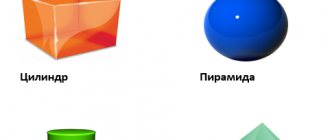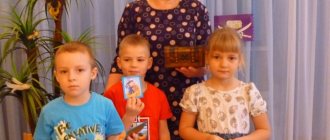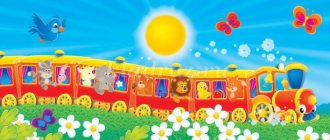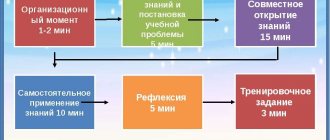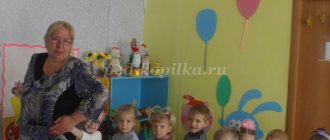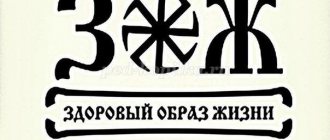Goal: Testing mathematical knowledge in a playful, entertaining form: in counting, the ability to independently complete tasks in a competitive environment.
Objectives: Educational: Learn to solve problems involving increasing and decreasing a number by several units. Strengthen counting within 8, knowledge of numbers up to 8. Developmental: Form in children ideas about the relationships of numbers in a number series, identify and name the previous and subsequent ones in relation to the named number (numbers and “neighbors”). Develop attention, memory, thinking. Educators: Develop the ability to work in a team, provide assistance, support, endurance and patience.
Materials, tools, equipment: Demonstration material: a set of numbers from 1 to 8, cubes, 3 hoops, multi-colored apples made of colored paper. Handouts: geometric shapes, cards with numbers.
Vocabulary work: Digital city, numbers “neighbors”, travel, right, left, below, up, around, previous, next.
Preliminary work: introducing children to the number and number 8, time of day, problem solving.
Methods and techniques: game motivation, questions for children, explanation, instructions for implementation, practical actions of children, musical accompaniment, didactic games.
OOD progress:
1. Organizational moment Communicative exercise “Hello.” Educator. Today we are going to the amazing country of Mathematics. In the capital of the country of Mathematics - Digital City - we will play, count and solve fun problems. And to get to the country of Mathematics, you need to close your eyes and say the magic words: “1, 2, 3, 4, 5 We begin to play! We close our eyes, We find ourselves in the country of Mathematics! (the teacher puts on a cape, a crown, turns into a fairy Mathematics) Fairy. I am glad to welcome you to my city Tsifrograd! But you can't just come here. You need to solve fun problems and show the answers in numbers.
2. Warm up. Solving problems involving increasing and decreasing a number by several units. 1) How many boots did Olya buy so that the cat wouldn’t get her paws wet? (4) 2) Seryozhka fell into the snow, and behind him - Alyoshka, And behind him - Irinka, and behind her - Marinka, And then Ignat fell, How many guys are there in the snow? (5) 3) On Andryusha’s saucer are four yellow pears. The child wanted to eat, and he ate one of the pears. Now count the pears on Andryusha's saucer. (3) 4) A hedgehog walked through the forest, Found mushrooms for lunch: Two under a birch tree, One at an aspen tree, How many of them will there be in a wicker basket? (3) 5) Five puppies Plus mother - husky. How much will? Count it up! (6) 6) Six cheerful bear cubs are rushing into the forest to pick raspberries, But one baby is tired, Has fallen behind his comrades, And now find the answer: How many bears are ahead? (5) (cards with numbers are arranged on a magnetic board in a different order) Fairy: Guys, you solved the problems correctly! Therefore, I invite you to the land of Mathematics. Do you know that bears in my country love mathematics, they know how to solve problems, add and subtract, and also have fun and play. I invite you to play too.
Physical education minute. Song of a teddy bear (ry - ra - ru).
3. Didactic game “Fold the house.” Fairy: One bear cub, in my country, does not have his own house. He knows a lot of geometric shapes and wants to build a house out of them, but doesn’t know how. Shall we help him? Geometric shapes are waiting for you on the table. Fairy: You have created wonderful houses! What geometric shapes did you use? There are so many houses, but only one bear. He will choose a house for himself, but what to do with the rest of the houses? Can I give these houses to the residents of my fairy-tale country?
4. "Game with apples." Fairy: The bear already has a house, but let's treat the bear with apples. Apples are not simple, with different numbers of seeds inside. You will run to the music, and as soon as it stops, take one apple at a time. Count the seeds in the apples and stand near the number in the hoop. How hard you tried! All the apples have been collected. Tired. It's time to relax!
5. Physical education (with musical accompaniment)
6. Didactic game “Live numbers”. Fairy: Have you rested? And in my country, Mathematicians, there are living numbers. Do you want to play with them? Cards with numbers are laid out on the table. Children take them and insert them in order from 1-8. The teacher suggests making a count: quantitative, reverse. Tasks: - Show the “neighbors” of the number 5 and name them. - Show the “neighbors” of the number 7 and name them. - Show the number 1 more than 2. - Show the number 1 less than 4. - Show the number before the number 8. - Show the number after the number 5. - Show the number to the right of the number 4. - Show the number to the left of the number 7.
7. Didactic game “Find the number.” (children stand in 2 teams) Rules of the game: Come to me! There are cubes in front of you. Yellow cubes and green cubes. I'd like you to count them. And to do this you need to split into two teams. Team 1 goes around the yellow cubes and counts them. Team 2 goes around the green cubes and counts them. Each participant takes a card with a number corresponding to the number of cubes passed. Team 1, show cards with numbers. How many cubes? How to check who counted correctly? 2nd team, show cards with numbers. How many cubes? How to check who counted correctly?
8. Reflection. Fairy: Guys, you completed all the tasks! Well done! We will continue to meet with you, but now it’s time for me to leave, and it’s time for you to return. Close your eyes. 1, 2, 3, 4, 5 We're done playing. We close our eyes and leave the fairy tale!
Educator: Our journey has ended. Where have you been? What did you like about the country of Mathematics?
Author: Marina Evgenievna Levicheva, teacher, GBOU school No. 842, preschool department building 137, Zelenograd, Russia
The article is published in the author's edition
Mathematical holiday for children of senior preschool age
- July 20, 2010
Competition “My Pedagogical Initiative”
Program content:
- Bring children joy and pleasure from educational games.
- Maintain interest in intellectual activity, the desire to play games with mathematical content, showing persistence, dedication, and mutual assistance.
- Develop basic skills of algorithmic culture of thinking, the ability to perform actions in the mind; identify and abstract two properties.
- Consolidate the acquired knowledge:
- 1) knowledge of numbers from 1 to 10;
- 2) the ability to compare strips by length;
- 3) the ability to compose cut pictures into 5-6 parts;
- 4) the ability to solve mathematical riddles.
Characters:
- Presenter
- Baba Yaga
- Koschei the Deathless
- Queen of Mathematics
The progress of the holiday
The hall is decorated with mathematical symbols. In the background there is a fairy-tale house in which sits the Queen of Mathematics and Koschey the Immortal. The house is entangled with chains and locks.
Children, divided into two teams, enter the hall and sit on chairs around two tables. Beautiful festive music sounds.
Presenter: Guys, today, in this wonderful hall, we have a Mathematical Holiday, but let's wait a little, since the Queen of Mathematics herself promised to come to us. As soon as she arrives, we will begin our holiday.
The door opens and Baba Yaga runs in.
Baba Yaga: Oh, I'm running, I'm running, I'm all here, I'm here, everything is fine, we can start!!!
Presenter: Guys, do you think this is the Queen of Mathematics?
Baba Yaga: What are you talking about? I am the real Queen of Mathematics, and if you don’t believe me, then I will leave, let the holiday be without me - sit here and be bored!
Presenter: Come on, don’t be upset, you don’t need to leave. We will now check if she is telling the truth. Guys, let's tell her some math riddles.
Children ask riddles:
Three little bunnies, five hedgehogs. They go to kindergarten together. We'll ask you to count how many kids there are in the garden.
Baba Yaga: Well, well, let me think, that means three hares and five hedgehogs, well, that’s easy, only 10, because hares are very voracious, we can assume that there were 5 of them.
Five pies were in a bowl. Lariska took two pies, her pussy stole another one, and how many were left in the bowl?
Baba Yaga: Oh, this Lariska, oh, this pussy - apparently they love pies, they probably all ate them and didn’t leave a single one for the beautiful granny. Zero, zero pies left - we ate them all!!!
Our cat has five kittens, sitting side by side in a basket. And the neighbor's cat has three! So cute, look! Help me count, what is three and five?
Baba Yaga: How can I know how many of these kittens there are, three, five - in general, a lot of these kittens!!!
Presenter: Yes, you are not the Queen of Mathematics. Do you know what our Queen thinks? She knows everything about numbers, numbers, geometric shapes... Guys, I think this is Baba Yaga!
Baba Yaga: No, I am the Queen, the Queen of Mathematics!!!
Voice from behind the house: Don't believe her, guys! This is Baba Yaga, she hid me behind locks, and Koschey the Immortal watches over me day and night.
Baba Yaga: Well, everything has been revealed, I didn’t manage to be the Queen of Mathematics. Come out Kosha, sit here, look at the guys, remember them - they’re pretty, smart, reasonable, they know everything, I couldn’t deceive them, we won’t take them to our team!
Koschey the Immortal comes out, wearing a chain with keys to the locks on his chest. Each key is shaped to fit the lock - children need to match the key to the appropriate key.
Presenter: Baba Yaga, Koschey the Immortal, why are you so angry! The guys came to the party, and you are hiding the Queen! Free her please!
Baba Yaga: Okay, I will fulfill your request if you answer my questions and complete all the tasks correctly. Can you handle it, guys? Then the first task. Game "Live Numbers"
Children are given cards with numbers from 1 to 10; children must line up to the music. The task becomes more complicated, you need to stand in reverse order - from 10 to 1.
Baba Yaga: Well done guys, you completed the task! Give them the key, Kosha. (Koschei gives one of the children a key). If you pick up the key to the lock, only then will it open.
The child picks up the key to the lock. Koschey removes the chain.
Baba Yaga: One day my broom failed me and I had to land in a swamp. And in the swamp, the hummocks are in the form of geometric shapes. You need to arrange the hummocks in the swamp as shown in the diagram on the screen. Place the pieces correctly and you will receive another key.
The plan is displayed on the screen:
The presenter draws the children's attention to the fact that in the lower left corner there is 1 bump - rectangular, blue, and then an oval bump, purple, etc. Children lay out the figure according to the plan (the figures are made of foam rubber and covered with colored fabric). Then Baba Yaga asks one of the children to guide her over the bumps, in order.
After completing the task, Baba Yaga orders Koshchei to give him another key, the children remove the second chain with the lock.
Baba Yaga: And now I will give you another task. I decided to buy rugs for my hut, but the rugs are not simple, but modern, with a pattern of geometric shapes. You need to decorate the white rug like in these pictures. If you succeed, you will receive another key. And while you are decorating the rugs, I will have fun with the guests and see how they cope with mathematical riddles!!!
Baba Yaga asks riddles to the guests of the holiday:
Along the ravine walked a cap, two scarves, three baskets, and behind them walked stubbornly a snow-white Panama hat. How many guests were there in total? Answer quickly! (4)
One evening the bear’s neighbors came to have a pie: a hedgehog, a badger, a raccoon, a “squint”, a wolf with a tricky fox. But the bear could not divide the pie among everyone. The bear was sweating from labor - he didn’t know how to count! Help him quickly - count all the animals. (7)
Seven cheerful piglets stand in a row at the trough. Two went to bed, how many pigs are there in the trough? (5)
Four goslings and two ducklings swim in the lake and scream loudly. Well, quickly count - how many babies are there in the water? (6)
At the market, a kind hedgehog bought boots for the family. Boots that fit your feet, a little smaller ones for your wife. With buckles - for the son, with clasps - for the daughter. And he put everything in a bag. How many legs does a hedgehog have in a family? (16)
After the riddles, Baba Yaga checks the completion of the task by the children.
Baba Yaga: Give them the third key, Kosha, they completed this task too.
Baba Yaga: And now a competition for team captains. Look, while I was flying over the fields and forests, mice entered my hut and tore up all the pictures from my favorite cartoon. You need to correctly put together my favorite pictures, if you do it, you will get the key.
Baba Yaga: In the meantime, the captains are putting together pictures, for you guys, my difficult logical relay race. You need to enter the desired picture one by one, do it, and get the key.
Queen of Mathematics (voice from the hut): Hurry up, guys, and try not to make mistakes!!!
Baba Yaga: I screamed here, as soon as they cope, we’ll let you out, but if they don’t cope, excuse me, you’ll live with us and teach us mathematics!!!
"Logic relay race".
The teams on the Whatman paper are given logical chains that they must complete.
After completion, the fourth key is given.
The captains are checked and the fifth key is given.
Baba Yaga: Well, well done. They cope with all tasks... So, to make it even more difficult for you to come up with...? A! Now I’ll play the game “Say the other way around” with you. I say a word, and you tell me the opposite word, an antonym. Will you try it? Then listen:
High - low Loud - quiet Wet - dry Clean - dirty Wide - narrow Deep - shallow Strong - weak Big - small Narrow - wide Left - right Front - back Bottom - top Hot - cold
Baba Yaga: Well, well done guys, you completed this task too! Give them, Kosha, the sixth key! Koscheyushka, there’s only one lock left! These are some smart kids. Okay, let me give them one last task. Let them be without their Queen a little longer.
Baba Yaga: Look, I have children’s faces in the envelope, and a small village is drawn on the easel. You need to settle the children as I tell you, and Koshchei and I will check.
Each child is given a face (on an adhesive base or tape), in turn, each is given the task:
1. Olya lives in the lowest building on the 4th floor in the apartment on the left.
2. Denis lives in a house that is located between the highest and lowest building on the 5th floor in the apartment on the right.
3. Sonya lives in the tallest building on the 8th floor in the apartment on the left.
4. Serezha lives on the floor above Sonya, in the apartment on the right.
5. Katya lives in the middle house in the apartment on the left.
6. Maxim lives in the tallest building on the 6th floor in the apartment on the right.
7. Arseny lives in the lowest building on the 2nd floor in the apartment on the left.
Presenter: Well, Baba Yaga, our children have completed their tasks, give us the last key.
Baba Yaga gives the key, the door opens. The Queen of Mathematics enters to the accompaniment of solemn music.
Queen of Math: Thank you guys! It’s not for nothing that you spend so much time studying mathematics. You completed all the tasks and helped me free myself. As a reward for your intelligence and ingenuity, I want to give you gifts, and you, Baba Yaga and Koschey the Immortal, will now go to school to gain intelligence and after all the lessons, you will not have time for pranks, but will be with kids compete to see who is smarter and more savvy.
Presenter: Thank you, Queen of Mathematics, thank you, Baba Yaga and Koschey, for coming up with interesting tasks for us, and now let's say goodbye to our guests! Goodbye!!!
Author: Liliana Anatolyevna Ponomareva, senior teacher of the 1st qualification category of MDOU No. 2 in the village of Afrikanda, Murmansk region, work experience in the position - 4 years
About myself: I have been working at MDOU No. 2 as a senior teacher since 2006. I really love my job and my team. Working as a senior teacher, you realize all the responsibility for the quality work of teachers, for their development, for their comfort in the workplace. I believe it is necessary to create such conditions so that educators feel the need for innovation and enjoy creativity in the workplace. If the teacher is interested in creating, it means that the children will be interested, and parents will be calm about the development of their children. That is why I always take part in the development of all kinds of scenarios and lesson notes. I offer a script for a math holiday for older preschoolers, which we held at a city workshop.
Liliana Anatolyevna Ponomareva
Photo by the author
Technology for conducting mathematical leisure in kindergarten.material
Department of Education
Shushensky district administration
Ilyichevsk municipal budgetary preschool educational institution No. 2 kindergarten “Zhuravushka”
Educational practice
"Technology for conducting mathematical leisure in kindergarten."
Prepared by: senior teacher Skripacheva E.N.
Leisure activities in kindergarten are carried out through the organization of recreation, entertainment, holidays in free time, as well as through self-education and creative activity.
Currently, most leisure time is devoted to games, musical entertainment, literary creativity, and not even a small part of the leisure time of preschoolers is devoted to mathematics.
However, preschool children show spontaneous interest in the shape, quantity and other characteristics of objects in the world around them.
The leisure and entertainment activities we have developed and tested are designed to teach preschoolers mathematics in a playful, entertaining way.
Let the children not see that they are being taught something. But unbeknownst to themselves, while having fun, preschoolers count, add, subtract, and, moreover, solve various kinds of logical problems that form certain logical operations. This is interesting for children and the role of an adult in this process is to maintain the children’s interest.
A preschool institution is an effective means of organizing meaningful leisure time for the formation of children's physical education skills, subject to the following conditions:
— interaction between teachers and parents in the field of organizing meaningful children's leisure time. The task of preschool teachers is to attract the attention of parents to the problem of organizing children's leisure time with a mathematical focus. To solve this problem, the following are appropriate: thematic conversations and “open days for parents”, exhibitions of children’s photographs (“This is us in our leisure hours”, the holiday “In the Land of Mathematics”);
— use of pedagogical technologies (game technologies, TRIZ, ICT, etc.);
— creation of a developing subject-spatial environment in kindergarten.
The teaching staff was faced with the task of finding ways, forms, means and methods that would combine knowledge and entertainment into a single whole.
Basic forms and methods of mathematical leisure:
Leisure methods: play, competition, improvisation.
Form of leisure: educational entertainment (cultural and leisure activities).
An interesting and accessible form of work are gaming, musical, mathematical, and creative hours.
Game clock. During the game hour, children fix the number and score in the role-playing game “Shop”. In the game “Architect”, children develop the idea that figures can be of different sizes. During outdoor games, the ability to determine spatial directions away from oneself and move in a given direction develops.
Musical clock: what can be combined with musical and mathematical content? These are rhymes and songs set to music that reflect the content of mathematical units (geometric figures, counting, problems, etc.), temporal and spatial relationships - musical notation (notes as signs and their location on the staff, concepts above, below, etc. .d.).
Memorizing rhyming rhymes during literary hour.
Math hour. Children are offered entertaining mathematical material: puzzles, rebuses, labyrinths, riddles, joke problems, “Tangram”, “Columbus Egg”, “Pythagorean Square”, checkers, board games, and didactic games with a mathematical bias. Entertaining mathematical games are also used to organize children’s independent activities.
Creative hour. A variety of productive types of children's activities (drawing, modeling, appliqué).
The technological algorithm for mathematical leisure is carried out in the following stages.
Preparatory stage.
1. Study of teaching aids on this issue. It is necessary to clarify what mathematical concepts and to what extent should be formed in this age group.
Methodological support for the educational field “Cognitive Development” in terms of FEMP is presented by the Program “Formation of elementary mathematical concepts in kindergarten”, author Natalya Aleksandrovna Arapova-Piskareva. The program is divided into sections: “Quantity and counting”, “Size”, “Form”, “Orientation in space”, Orientation in time.” We will look at the example of the middle group of Ilyichevsky MBDOU d/s No. 2 “Crane” in the section: “Form”.
2. Determine the level of development of mathematical concepts in this age group.
To do this, we use pedagogical diagnostics, which is carried out during observations of children’s cognitive activity in spontaneous and specially organized activities. Toolkit for pedagogical diagnostics - observation cards of child development, which allow recording the individual dynamics and development prospects of each child in the course of cognitive activity (FEMP).
Not only exercises are used to identify geometric shapes, but also games with sand, which contain additional opportunities for developing this topic: you can use buckets to build identical towers and towers of different sizes. While working with mosaics and construction sets, you can invite children to lay out a pattern of identical parts and different ones in shape. The entire pattern is analyzed.
3. Determine the program content of mathematical leisure “Space travel to the planet Formados”:
— Learn to correlate the shape of objects with geometric figures (when building a spaceship).
— Expand ideas about a rectangle based on comparing it with a square (planar image of robots made from geometric shapes).
— Improve the ability to distinguish and name a circle, square, triangle, rectangle (plane image of aircraft from geometric shapes).
— Develop the ability to work in a team, provide assistance, support, endurance and patience.
4. Think over the content of mathematical entertainment (if there is mathematical entertainment that is suitable for the topic, you can take it from methodological literature or from electronic applications).
5. Think over and prepare material for conducting. You can prepare the material yourself, or you can involve children and parents in its production. If the entertainment involves the presence of parents, then it is necessary to prepare and distribute invitations.
6. Preparing children for mathematical entertainment as needed (memorizing poems, preparing a theatrical performance, learning a certain role depending on the script).
7. It is necessary to inform about the time and day of the entertainment in advance so that this event is welcome and long-awaited. This will keep children interested.
Formative stage
Carrying out mathematical entertainment:
1. In the introductory part, music was used, a surprise moment: a resident from the planet Formados arrived and said that they had a problem; the Formados had invented highly developed robots to make their work easier. Everything was fine on the planet until robots began to improve. Among them appeared the main robot named Force. He created an army of robots, built a huge spaceship and settled on the satellite of Formados. Now evil and soulless machines threaten the inhabitants of the planet. The Formados ask the inhabitants of Earth for help. It is necessary to save their planet from destruction and prevent evil from spreading throughout the Universe.
2. In the main part, children performed various tasks: built a spaceship from three-dimensional figures (cube, cone) for a flight to the planet Formados; welcomed Formados (theatrical performance). They told what the earth is like; assembled aircraft for the inhabitants of the planet Formados (plane image); robots. As a result, the planet Formados was freed from the evil mind of the machines. The children helped the Formados in arranging their planet.
3. In the final part, it is recommended to give children incentive prizes. Prizes can be sweets or some toys.
The final stage
Analysis of the level of formation of mathematical concepts.
During the school year, the middle group had 3 mathematical activities in the sections: “Quantity and counting”, “Orientation in space and time”, “Form”.
Work on the formation of mathematical concepts in preschoolers was carried out in two successive, interconnected substages:
— preparatory: the purpose of which was to repeat the material obtained in the classroom and necessary for further work;
- main: at which a series of events were held aimed at consolidating and deepening the acquired knowledge.
The results of pedagogical diagnostics carried out during leisure time were used to solve the following educational problems:
- individualization of education (for 3 children an educational trajectory was built to develop mathematical concepts, for one child professional correction of developmental characteristics was required);
- optimization of work with a group of children.
The role of leisure activities in the formation of mathematical concepts is very significant. Leisure helps to maintain a child’s interest in mathematics, develops independence and provides an opportunity to develop creatively. The principles of planning and conducting leisure activities make it possible to identify “gaps” in the knowledge of preschoolers and direct leisure activities to eliminate them, which allows the teacher to flexibly respond to the actual level of development of elementary mathematical concepts in children.
List of used literature:
1. From birth to school. Approximate general educational program for preschool education / Ed. NOT. Veraksy, T.S. Komarova, M.A. Vasilyeva. – M.: Mosaic – Synthesis, 2014. – 336 p.
2. Arapova - Piskareva N.A. Formation of elementary mathematical concepts: Program and methodological recommendations. – M. Mosaic – Synthesis, 2014.
3. Pomoraeva I.A., Pozina V.A.. Formation of elementary mathematical concepts: Middle group. – M.: Mosaic – synthesis, 2014. – 64 p.
4. Beloshistaya A.V. Teaching mathematics in preschool educational institutions: a methodological manual. – M.: Iris – press, 2005. – 320 p.
5.Demina E.S. Development of elementary mathematical concepts. – M: TC Sfera, 2009. – 128 p.
6. Zatsepina M. Holidays and entertainment in kindergarten. – M.: Mosaic – Synthesis, 2008. – 144 p.
